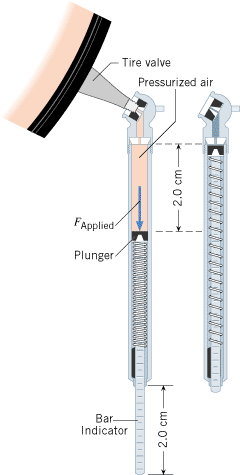In a tire pressure gauge, the air in the tire pushes against a plunger attached to a spring when the gauge is pressed against the tire valve, as in Figure 10.2. Suppose the spring constant of the spring is k![]() =
=![]() 320 N/m and the bar indicator of the gauge extends 2.0 cm when the gauge is pressed against the tire valve. What force does the air in the tire apply to the spring?
320 N/m and the bar indicator of the gauge extends 2.0 cm when the gauge is pressed against the tire valve. What force does the air in the tire apply to the spring?
 |
|
Reasoning
We assume that the spring is an ideal spring, so that the relation  is obeyed. The spring constant k is known, as is the displacement x. Therefore, we can determine the force applied to the spring.
is obeyed. The spring constant k is known, as is the displacement x. Therefore, we can determine the force applied to the spring.
Solution The force needed to compress the spring is given by Equation 10.1 as
 |